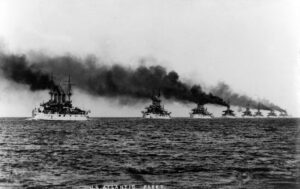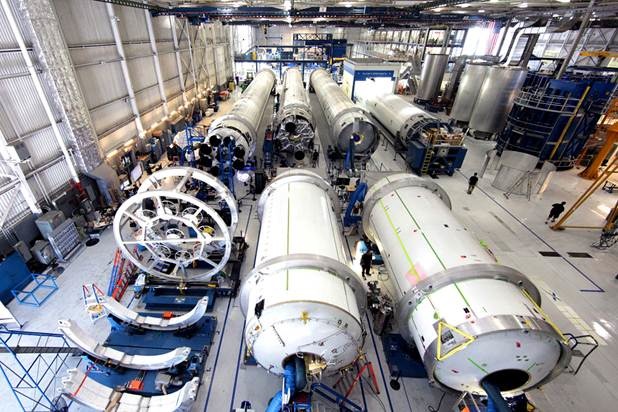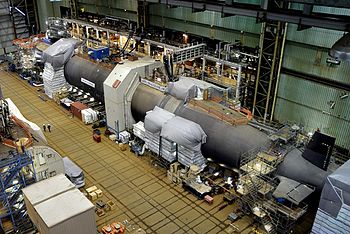Trump Acts To Revitalize America’s Defense Industrial Base
Posted on

The future USS Ford is christened at Newport News shipyard.
President Donald Trump has identified a fact few of his recent predecessors have understood: the Defense Industrial Base of the United States (DIB) is a critical component of our national security. The DIB is more important than any individual weapons program – be it an aircraft carrier, long range bomber, or high-tech tank. But for too long, the DIB has been ignored, mismanaged or even attacked.
With his signing of an executive order to review and revitalize America’s industrial base, the president has taken the first step to rebuilding the nation’s defense infrastructure. This will also encourage the restoration of redundancies in our industrial capability that are crucial both in peace time and in times of war. Like Ronald Reagan, President Trump also understands that DIB jobs are high-paying and give skilled workers in regions that have suffered from economic neglect a chance to get back to work in our factories and shipyards.
That he chose to sign the executive order on the USS Gerald Ford aircraft carrier Friday carries real symbolism. Only America has the capacity to build a super carrier. The Russians want such ships but cannot construct them and even the Chinese, with all of their recently-acquired shipbuilding prowess, are years away from replicating the Ford-class carriers that will soon enter America’s fleet. But this technological and manufacturing edge can no longer be taken for granted as the nation’s DIB becomes increasingly fragile.
 With his focus on the DIB, Trump now follows in the footsteps of both Roosevelt’s, Theodore and Franklin. Each President Roosevelt served as the assistant secretary of the Navy, managing the rapid expansion of the US Navy prior to the Spanish-American War (Theodore) and World War I (Franklin). These experiences dramatically informed their understanding of the DIB during their presidencies. For Theodore Roosevelt, it was the “up-building” of the Great White Fleet that heralded the United States’ emergence as a world power at the dawn of the twentieth century. His cousin, Franklin, was required to shift the entire American economy to war footing, altering Detroit assembly lines from automobiles to bombers while building warships on the Ohio and Mississippi rivers. That incredible output turned the tide of the war and defeated the Axis.
With his focus on the DIB, Trump now follows in the footsteps of both Roosevelt’s, Theodore and Franklin. Each President Roosevelt served as the assistant secretary of the Navy, managing the rapid expansion of the US Navy prior to the Spanish-American War (Theodore) and World War I (Franklin). These experiences dramatically informed their understanding of the DIB during their presidencies. For Theodore Roosevelt, it was the “up-building” of the Great White Fleet that heralded the United States’ emergence as a world power at the dawn of the twentieth century. His cousin, Franklin, was required to shift the entire American economy to war footing, altering Detroit assembly lines from automobiles to bombers while building warships on the Ohio and Mississippi rivers. That incredible output turned the tide of the war and defeated the Axis.
 As the Cold War moved into full-swing, five star general-turned-president Dwight Eisenhower’s launched the Solarium project. The wise men of Solarium reviewed the entire breadth and depth of the American economy, identifying the areas to be strengthen if the United States was to win its competition with the Soviet Union. Not surprisingly, much of the focus of the project was on America’s DIB. The Trump White House’s National trade Council its Industrial policy shop has come to the same conclusion today that the Solarium scholars did in the 1950s.
As the Cold War moved into full-swing, five star general-turned-president Dwight Eisenhower’s launched the Solarium project. The wise men of Solarium reviewed the entire breadth and depth of the American economy, identifying the areas to be strengthen if the United States was to win its competition with the Soviet Union. Not surprisingly, much of the focus of the project was on America’s DIB. The Trump White House’s National trade Council its Industrial policy shop has come to the same conclusion today that the Solarium scholars did in the 1950s.
Like the Roosevelts, Eisenhower and Reagan before him, President Trump has inherited a world in crisis. A resurgent and aggressive Russia, a rising and assertive China, an Iran intent on establishing a Middle East hegemony and a nuclear-crazed rogue-state North Korea all are undermining the free market and rules-based international order that America has encouraged and protected for decades. In light of these challenges, a vibrant United States DIB is an imperative today just as it has been in past eras.
Trump’s executive order is necessary to address a generation of neglect of the DIB that followed the West’s victory in the Cold War. Dramatic contractions in defense spending, especially the Obama Administration’s sequestration program that it exacted from Congress in exchange for reopening the government, waves of industrial mergers and defense contractor consolidations and naïve strategic assumptions regarding the “end of history” have left the America’s DIB fragile and lacking in redundant capability. Trump’s executive order requires the government undertake a thorough inventory of the breadth and depth of the nation’s DIB so the administration can identify where it is thin and requires strengthening.

SpaceX Falcon 9 rockets in production.
Unfortunately, many policy makers’s understanding of the DIB begins and ends with seeing ships, planes and tanks rolling off the factory assembly line. While impressive, the port, tarmac or tank parking lot give a very limited view of the DIB. What is not seen are the thousands of individual part and component manufacturers who supply the nation’s big defense factories. A missile assembly line in St. Louis may employ 500 people, but there are likely to be over a 1,000 workers, spread across the country, manufacturing the various parts that combine to produce just one of the missiles that ultimately rolls of the line.
Often, there are many suppliers of ubiquitous nuts, bolts and screws that go into a weapon, which is how it should be. In other cases, however, there is merely one supplier in the entire country of a key widget or component upon which an important weapon’s platform depends. It is well-known, for example in defense circles that critical items such as five-axis tooling machines or circuit boards, are in very short supply. Consequently, the DIB, like the nation’s overall economy, has come to depend on foreign manufacturers, including some that are China-based, for important defense components. Few questions are being asked in Washington how the nation might gain access to these foreign components in a time of war.
The narrowing of the country’s DIB is not just limited to subcontractors and suppliers. It has affected America’s great companies as well, many of which no longer exist. In the past, the United States boasted 10 major military aircraft manufacturers. Today we have four. During World War II, we had over 50 shipyard dry docks capable of producing warships over 400 feet in length, some of them on the Ohio and Mississippi rivers. Today we have 12. Even among the dozen, several are under economic strain. America is down to one tank factory and it only produces a handful of tanks per year and exists only at the insistence of Congress, which has fought to keep it open.
The DIB is not just the sum of components, platforms, contractors and factories. It is also composed of the hundreds of thousands of welders, electricians, pipefitters, metal workers, heating and air conditioning specialists, tool makers, composite material molders, engineers, scientists, logistics specialists, test pilots and managers who actually invent and build our weapons systems. All of these jobs, and many more, skilled blue collar and while collar positions alike, are critical to the our country. They are solid, stable occupations that enhance our nation’s defense while also providing comfortable middle and upper income livings for the men and women engaged in them. Yet these jobs have disappeared at an alarming rate as the DIB has shrunk. Once the critical skills they embody are lost, it is very difficult to reconstitute them within the workforce. Thus, America’s current and future skilled defense industry work force should also benefit from the President’s executive order.

USS Colorado, A Virginia-class submarine, in production
We recognize that in today’s economy, with its global supply chains and “just-in-time deliveries”, redundancy signifies inefficiency and waste. We are free marketeers and agree that the DIB should operate as efficiently as possible, but we reject the idea that all redundancies should be wrung out of the base or that we should be content to rely on foreign competitors for our national security.
It was not too long ago, at the height of the Cold War, that our national leadership was concerned about where important elements of our national defense could be produced if Soviet or Chinese nuclear strikes destroyed our major centers of manufacturing. Given the range of threats today, from asymmetric strikes and terrorism from Iran, North Korea or non-state actors to a peer competitor conflict with Russia or China, it is time again to care about a level of redundancy in the physical plants of our DIB.
Similarly, we do not have the luxury of simply assuming continued access to key foreign components in a time of crisis or war a time of war. For example long-range missiles are built with components that contain rare earth minerals that currently are only mined in China. In a crisis or conflict with China, such materials would no doubt be cutoff. Many key rare earth minerals are found and could be mined in the American West on a relatively cost-efficient basis but they are not for lack of encouragement from the federal government and industry, which has become complacent in its reliance on China.
We expect that President Trump’s executive order with lead to a true revitalization of America’s defense industrial base – both its physical plant and its skilled workforce. We believe that it will likely lead to the requisite level of redundancy returning to the defense sector. As a result, America will gain strength, which will go a long way to ensuring the peace during this time of crisis and uncertainty in the world. We applaud the President and his team for taking this important step as he joins an elite club of past presidents who had a similar vision.
Jerry Hendrix, a retired U.S. Navy captain and award-winning naval historian-strategist, is a naval expert at the Center for a New American Security. Follow him @JerryHendrixII
Robert C. O’Brien, a partner at Larson O’Brien LLP, served as a national security advisor to Scott Walker, Mitt Romney, and Ted Cruz during their presidential campaigns. His book: While America Slept: Restoring American Leadership to a World in Crisis (Encounter Books) was released in September. Follow him on Twitter @robertcobrien.
Subscribe to our newsletter
Promotions, new products and sales. Directly to your inbox.
